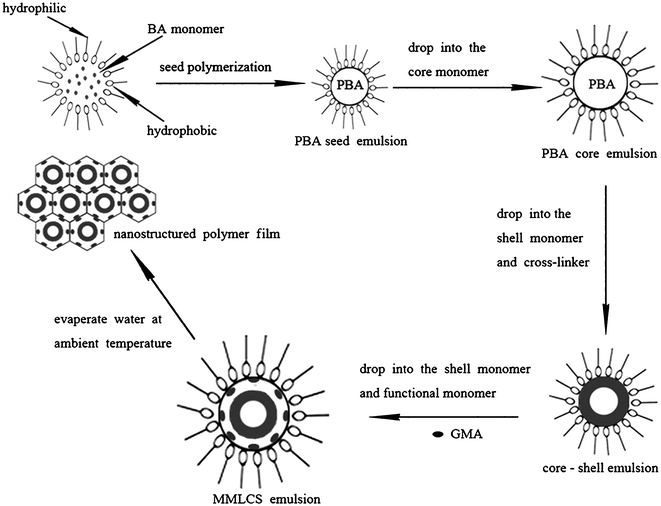Soft Shell Comprising a Polybutadiene Rubber Core-Shell Polymer
In Specific Implementation Method 25, the epoxy matrix resin in this embodiment consists of 40 parts by mass of F-44 phenolic epoxy resin, 60 parts by mass of E-51 epoxy resin, 5 parts by mass of a core-shell polymer, 16 parts by mass of 4,4'-diaminodiphenylsulfone curing agent, 8 parts by mass of dicyandiamide curing agent, and 5.0 parts by mass of 3-phenyl-1,1-dimethylurea curing accelerator. The core-shell polymer is composed of a soft core of polybutadiene rubber and a hard shell of polymethyl methacrylate.
The core-shell polymer mentioned in this embodiment is added as a parent mixture of Kane Ace MX-125 produced by Kaneka Company in Japan, with a mass content of 25%, featuring a soft core of polybutadiene and a hard shell of polymethyl propionate, with a particle size of 100nm. The mass content of B-51 epoxy resin is 75%.
Performance testing is conducted on the cured product of the epoxy matrix resin in this embodiment, cured at 120 °C for 2 hours, using the methods and parameters recorded in Specific Embodiment 1. The results indicate that the glass transition temperature is 137.3 °C, impact strength is 16.8KJ/m, tensile strength is 83.5MPa, tensile modulus is 3.4GPa, breaking elongation force is 3.5%, bending strength is 126.4MPa, and bending modulus is 3.4GPa. The epoxy matrix resin in this embodiment exhibits excellent performance.
The distinction between the preparation method of the epoxy matrix resin in this embodiment and that recorded in Specific Embodiment 22 lies in Step 1. In this embodiment, 40 parts of F-44 phenolic epoxy resin, 45 parts of E-51 epoxy resin, 20 parts of Kane Ace MX-125 matrix mixture from Kaneka Company in Japan, 16 parts of 4,4'-diaminodiphenyl sulfone as a curing agent, 8 parts of dicyandiamide curing agent, and 5.0 parts of 3-phenyl-1,1-dimethylurea curing accelerator are weighed by mass. Subsequent steps involve adding the corresponding mass fractions of the substances weighed in Step 1.
Prepreg preparation is carried out using the method described in Specific Embodiment 23 but with the epoxy matrix resin prepared following the method described in this embodiment. The resulting prepreg, composed of epoxy matrix resin and SW110 glass fiber woven fabric (density 110g/m^2) according to Specific Implementation Method 25, has a volatile content of less than 1%, with the epoxy matrix resin having a mass content of 37% to 43%. The gel time of the prepreg is measured according to "HB 7736.7 Test Method for Physical Properties of Composite Prepreg Part 7: Determination of Gel Time," and the gel time of the prepreg at 120 °C is 9~20min.
After stacking the prepreg obtained in this embodiment, at least 3 layers of prepreg blanks are formed. The composite laminate is obtained by curing at 120 °C for 3 hours using a hot pressing tank process. The resulting composite laminate has a tensile strength of 598.3MPa, tensile modulus of 23.5GPa, bending strength of 785MPa, bending modulus of 24.2GPa, and layer shear strength of 81.2MPa.
In Specific Implementation Method 26, a comparative experiment is conducted with an epoxy matrix resin composed of 40 parts of F-44 phenolic epoxy resin, 60 parts of B-51 epoxy resin, 16 parts of 4,4'-diaminodiphenyl sulfone curing agent, 8 parts of dicyandiamide curing agent, and 5.0 parts of 3-phenyl-1,1-dimethylurea curing accelerator.
Performance testing is carried out on the cured product of the epoxy matrix resin in this embodiment, cured at 120 °C for 2 hours, using the methods and parameters recorded in Specific Embodiment 1. The results indicate a glass transition temperature of 137.8 °C, impact strength of 11.5KJ/m^2, tensile strength of 62.5MPa, tensile modulus of 3.6GPa, elongation at break of 2.7%, bending strength of 108.0MPa, and bending modulus of 3.5GPa.
